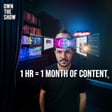Become a Creator today!Start creating today - Share your story with the world!
Start for free
00:00:00
00:00:01

The ULTIMATE ChatGPT Breakdown – Which Model Should You Choose?
In this AI marketing podcast episode, Dan Sanchez dives into the evolving landscape of ChatGPT, breaking down the six different models that are now available to users. Host Dan Sanchez takes a deep dive into each version—ChatGPT-4o, ChatGPT-4o Canvas, and the reasoning powerhouses o1iPreview and Mini—helping you understand how to leverage the right model for your marketing needs. Whether you're writing content, coding, or tackling complex reasoning tasks, you'll learn how each ChatGPT variant can optimize your workflow. Tune in to discover which ChatGPT model is right for you and how to unlock its full potential.
Past Episodes Mentioned:
- ChatGPT with Canvas: https://aidrivenmarketer.com/episode/the-magic-of-chatgpts-new-canvas-feature-for-content-marketing
- ChatGPT o1-Preview: https://aidrivenmarketer.com/episode/chatgpts-new-01-preview-model-what-it-means-for-marketers-6-use-cases
- Custom GPTs: https://aidrivenmarketer.com/episode/my-process-for-crafting-custom-gpts-ai-fundamentals-course-part-4
Timestamps:
- 00:00 – Introduction: Why ChatGPT is no longer one-size-fits-all
- 02:00 – Breaking down ChatGPT-4o and its capabilities
- 04:50 – ChatGPT-4o with Canvas: Collaboration made easy
- 08:30 – o1-Preview: The power of deep reasoning
- 12:20 – Mini Versions: Faster, cheaper, and built for scale
- 14:00 – Custom GPTs: Tailoring ChatGPT to your brand or needs
- 18:10 – Which ChatGPT model should marketers use?
- 20:45 – Final thoughts and call to action
Transcript
Introduction to Six New ChatGPT Tools
00:00:00
Speaker
Chat GPT is no longer just chat GPT. It is now six different models, six different tools that you can use to upgrade your marketing game. And in this video, I wanted to break down all six of them and talk about when to use what so that you can get the most out of this tool.
00:00:17
Speaker
All right, let's start with defining each tool and give it a little backstory before we actually jump into which ones you should use for which. Starting with the most recent one, and I'm gonna open up here on my desktop. If you're listening along, I'm explaining it so you don't have to watch the video, but it certainly helps to have a visual. So join us on YouTube or on aidrivermarketer.com where you can follow along visually.
ChatGPT Model Selection Complexity
00:00:38
Speaker
So I'm in chat GPT, and you can notice, if you haven't been here recently, then you,
00:00:43
Speaker
You probably don't know, but like there is a huge drop-down menu of which model to use and it used to be easy because it was just 4 and 3.5. It was like the new version and the old version, right? And everybody just used the newest version. But now there's multiple tools in here. So let's break them
Capabilities of ChatGPT 4.0 and Canvas
00:00:58
Speaker
down. We start off with chatgpt40. This came out last spring and it's now their most, you could say their most vanilla like leading model.
00:01:07
Speaker
And it's 4O, I think O stands for Omni, and it's essentially multi-modal, they call it. It can deal with text, it can deal with images, it can output voice, it now has the new voice feature, right? It can understand, not it doesn't just convert your voice to text and then another,
00:01:25
Speaker
creates the response and text and converts it to voice. No, it understands the sound of your voice natively and then converts that and can can have a conversation with you by converting it back to voice. It's very cool if you haven't tried the voice feature. But it's so nice. it it can It can be applied to so many different things. And this is just the generic version that but if you're not sure what you're using, you're probably just using 4.0.
00:01:46
Speaker
And this is their most up-to-date modern track. But of course, there's all kinds of variations of this now. So let's take a look at some of the others. There's chatgpt40 with Canvas. And if you haven't watched my last video, I go into depth about how to use Canvas. So go and check out that video, link in the description. But Canvas is the new model where it's essentially 4.0, but now if you ask it to create a written piece or code something for you, it opens up a separate window for you to be able to edit and kind of collaborate with chat GPT in order to like collaborate on a dock. It's almost like 4.0 as if Google Docs was loaded into it. You can collaborate on a document with the AI itself. It's really nice. Go check out that last video if you want to deep dive on Canvas though.
O1 Models: Preview and Mini
00:02:32
Speaker
The next one is O1 preview. This one just got released say about a month ago and it is OpenAI's reasoning model. It is slow by design in order to reason through problems. I've done another video on this. I'll link to that one too because it is mind-blowing good and its ability to overcome a lot of the limitations of 4.0 and a lot of the other AI models in being able to like work through normal like everyday things that we take for granted, it can now overcome them, like being able to count the amount of letters in a sentence.
00:03:05
Speaker
or the amount of R's in strawberry, it's famously known for getting wrong, it can now do because it can think logically and break break what's a simple problem for us down. It's also been known to do very complicated reasoning and and work through doctoral level problems and I've seen examples of people on Twitter, doctoral students working on a thesis and O1's able to crush it and work through the same amount of problems they've been spending years on trying to prove It can go through and maybe not create proofs, but honestly, due to the amount of reasoning coming to kalu conclusions that were very difficult before, O1 is starting to set a new new bar for what AI is capable of cognitively. From here, we have a bunch of sub-models of these three. We have O1 mini, which is a lighter version of O1.
00:03:53
Speaker
preview. And I'll get into why you would want to use this, but it's essentially a lighter version. You get more use cases of it, um it does what O1 preview does. It just doesn't do it quite as well. you're limited on Pro1 preview to 50 uses a week, which is plenty for most people. But if you ever need more reasons, you go use O1 preview, O1 mini. i We also have Jet GPT 4.0 mini, which is kind of like O1 mini, but O4 and just smaller and faster.
00:04:21
Speaker
We also have chat GPT for legacy, right? Which is the old model, the one that was the newest one up until just last April, oh when four O came out. That one is still available to use.
Custom GPTs for Marketing Efficiency
00:04:35
Speaker
And not to mention, beyond all these, you also have your custom GPTs, all the different customized versions of essentially 4.0, you have them loaded with instructions, with knowledge and documents and all kinds of things. So there's all those in the mix too. So now that the big question becomes, which one should you use when? So I'm going to open up my screen and take a look here.
00:04:59
Speaker
So starting with 4.0 to work back through our list, I'm going to say I'm going to start with 4.0 and this is like chat GPT plain vanilla, right? If you're not sure where to start, start with 4.0. It can solve most things. It's really great as a thinking tool, a brainstorming tool, coming up with content tool. It could do most things really well, but of course there are, and I would you recommend starting there, except there are some situations when some of the other models are better suited. If in doubt, just use 4.0, it's the standard model, it's the leading model, but there are certain certain situations that I use all the time where I'm starting to use some of these other models now.
00:05:38
Speaker
Moving it on to 4.0 with Canvas, this model crushes it when it comes to just writing content and creating code. I'm starting here first for all writing projects and all code projects, which I'm doing all the time as a marketer. And if you're a marketer, you're probably writing content all the time too. Shoot, even if I'm coming up with internal documentation like job descriptions, performance reviews, I'm using 4.0 with Canvas.
00:06:03
Speaker
It's in beta right now, but I find that it's fantastic at collaborating with AI in writing and with code so that you don't have to, it doesn't just give you a draft and you respond, you get a whole new draft. You can edit just parts of it or you can collaborate with it or do an overhaul with it and it all stays in the same place. so even if you're working on multiple documents. i've I had to come up with multiple job descriptions a few weeks ago, and I just knocked them all out one at a time. Once I got one locked in with a certain style, I was like, all right, now do the same, but for this job title. And here's some information about it. Bam, done it again. And then again, bam. I created multiple job descriptions in a very short amount of time because I had a document that was perfected with AI, and then I could duplicate over and over again. And that's the power. You could do that with blog posts, LinkedIn posts, Twitter posts. like Any time I'm coming up with content, I'm using Canvas now.
00:06:48
Speaker
O1 preview. Well, actually, before we dump and dive into O1 preview, let's talk about custom GPTs. Now, this is a topic I've covered multiple times on this podcast. I know lots of references back to old episodes, and I will link to those too. But chat g custom GPTs, every marketer needs to learn how to make these things because they are making life so much easier. And there's generally two different types of custom GPTs that I'm working with.
00:07:13
Speaker
There are the general custom GPTs and the specific custom GPTs. On your general ones, you can essentially load it up with all your brand information. And I make one of these per brand that I work with. load it with all the marketing information. Think about what you would give a new marketing hire. What would they need to know about the brand? Your mission? Your products? Your target audience?
00:07:35
Speaker
your value proposition to that target audience, maybe a breakdown of your most popular products, your messaging guides, your writing style, all the basic things that maybe if you were assigning a writer a the ability to write for you, what else would it need to know? You load it with all that stuff and then it becomes a better version of just the 4.0 model because it's already trained on who you are.
00:07:59
Speaker
And those are the ones, any time I'm doing any kind of work with AI for a company, I almost always just start with the general GPT that I've created for that brand because its ability to pull in the right context is very good and makes all of its outputs way better than if you were just working with the vanilla GPT because it's it's been trained just like a human. If it's trained on your brand, it's gonna be able to write better blog posts for you, so so is AI. So just treat it like a human, give it the context that it needs in order to work well for you.
00:08:29
Speaker
So that's the general custom GPT and I've gone and I'm not going to explain how to make it or more about it because yeah I've done it in other previous episodes.
Review of ChatGPT Tools for Marketing Advantages
00:08:38
Speaker
Link in the description. All the links are in the description. Now there are the specific GPTs or custom GPTs and those are ones that I make to accomplish very specific tasks over and over again. You can make as many as you want, but I have ones like my most, one I've talked about most on the show is the My Showrunner custom GPT. You can find it at myshowrunner.com if you want to have it for yourself or or even take the instructions and make your own. But it's a very specific GPT that just runs through podcasts pre-production and accelerates my pre-production time from an hour down to about five minutes.
00:09:12
Speaker
is very useful, but it's something that I do over and over again, and I pull that custom GPT, which now, again, only uses Chet GPT 4.0 model underneath, and then custom instructions and step-by-step guidance, and some knowledge of documents of examples and things loaded in it to just help it do those things more quickly, so I don't have to re-explain it every time. It's just loaded with the instructions.
00:09:32
Speaker
So I have multiple custom GPTs that accomplish a very specific use case over and over again. Every time I need to do the thing, I call up that custom GPT, and bam, we get it done together. So custom GPTs are what I do for a lot of different things. For any of those brand, general brand things, or very specific use cases, I'm using custom GPTs. So to kind of review, we have chat GPT 4.0, that's the vanilla version, that's good for everyday things.
00:09:58
Speaker
I have chat GPT-40 with Canvas, which I'm using now for all writing tasks and coding tasks because the Canvas model is just so useful. I can't wait for them to bake that into custom GPTs, by the way. that Pulling those things together would be ideal, but they're not right now. And then we have three custom GPTs to accomplish a bunch of general brand things and specific use cases. So what else do
O1 Preview for Complex Problem Solving
00:10:22
Speaker
we got? Let's take a look. We have O1 preview.
00:10:25
Speaker
01 Preview is a new model that came out about a month ago. Again, another video on that. I will link to it. But it is exceptionally good at deep reasoning. AI gets stuck sometimes. And I find that it's hard to get it unstuck, right? You've asked it to do things, and you're just kind of like, ah, chatPG, you just don't get it. Anytime you run into a scenario like that, anytime it's just not going deep enough where a human would be able to go, you're just like, AI is failing me?
00:10:55
Speaker
It's time for O1 preview. It's time to bring out the big guns. It kind of reminds me of a meme Where you have like a bolt on a car that's just not giving and this meme just goes sequentially through it I'll throw it up here in the video But like it starts at the little wrench and you're like not working. So you go to the bigger wrench I wasn't asking and then it goes to like a ah ah like a Huge wrench, you're like, you will obey. And then it goes to like the saw. Can't like won' can't stop me now, right? 01 is like the next level up where it's like, hey, you didn't work out before, so let's throw 01 preview at it. It's probably gonna get you unstuck. It's going to get you farther in being able to deal with the more difficult problems.
00:11:35
Speaker
So anytime I'm getting stuck with the other ones, I'm going to O1 preview and that generally fixes it. That's able to reason through the deeper things. If you find that it's just giving you shallow answers or it's just not taking everything into account or it needs to break something down more step by step, O1 preview is is your model.
00:11:53
Speaker
Okay, now let's move on to some of these other ones, which I don't find are very useful for marketers, so let's talk about what they are useful
Benefits of Mini Models for APIs
00:11:59
Speaker
for. That is 01 mini, which is the smaller version of 01 preview, chatgpt40 mini, and chatgpt4.
00:12:09
Speaker
So let's talk about the minis and then chatgpt4, starting with the minis. The minis are not really useful for us, unless you're using like O1 preview so much that you run out of your 50 use cases for it in a week, and then you just downgrade to O1 mini, it's faster.
00:12:26
Speaker
and you get more use cases out of it. So you can use that. Otherwise, it's really for the API that these things come in really handy. Because if you're using the API in order to do your AI work, then you might not just be doing a few or a dozen different instances of it. You're probably doing hundreds or thousands. You scale some kind of use case with it. Maybe you're having to go check surveys and summarize results. It's in the API that it makes more sense because it's not, it's it's charging you per use of it.
00:12:53
Speaker
and the minis are much cheaper than their bigger brothers. So if you want to save money and move it faster, that's when the minis start to become helpful you're using the API to accomplish things as a marketer. If you're not using the API, then but they're not really that helpful. So I'm not using them that much, but there are times where I'm using the API and it just makes sense to use the minis because it works faster and can get it done for much, much, much less. Sometimes like a tenth of the cost, the minis are costing.
00:13:22
Speaker
And that brings us down to chatgpt4, the legacy
Preference for Older Models vs. 4.0
00:13:26
Speaker
model. I think there were just people that got used to how it worked and maybe or aren't happy with 4.0. I'm really happy with 4.0. I think 4.0 does a great job, and 4.0 has gotten better even after they've released it just months ago. But some people are probably still using the legacy model. i don't I can't really think of why else you would want to use just chatgpt4 anymore, considering 4.0's better, faster, and can take more different inputs from a bunch of different directions from image and voice and can out and produce in both of those mediums. So that's it. That's the breakdown. Let me know in the comments which one you're using. And if this episode was helpful to you, please give it a thumbs up on YouTube or a rating that you feel like it deserves on whatever podcast platform you're listening to. I appreciate every single one.



![What’s Your Authority Score? [The 5-Factor Test] image](https://media.zencastr.com/cdn-cgi/image/width=112,quality=85/image-files/630c9f06819f8b3dba5fa460/cfbaccba-f587-45de-a41f-e2c99c15e2a5.png)
![The Audience Growth Engine [Full Framework] image](https://media.zencastr.com/cdn-cgi/image/width=112,quality=85/image-files/630c9f06819f8b3dba5fa460/46b84fd1-e856-4687-9aee-6b4a7e0bc7ff.png)



![The "Dream 100" Execution Plan [Google Sheet System] image](https://media.zencastr.com/cdn-cgi/image/width=112,quality=85/image-files/630c9f06819f8b3dba5fa460/fcd89374-76a4-4e58-a2e3-2bb7ddda4364.png)










